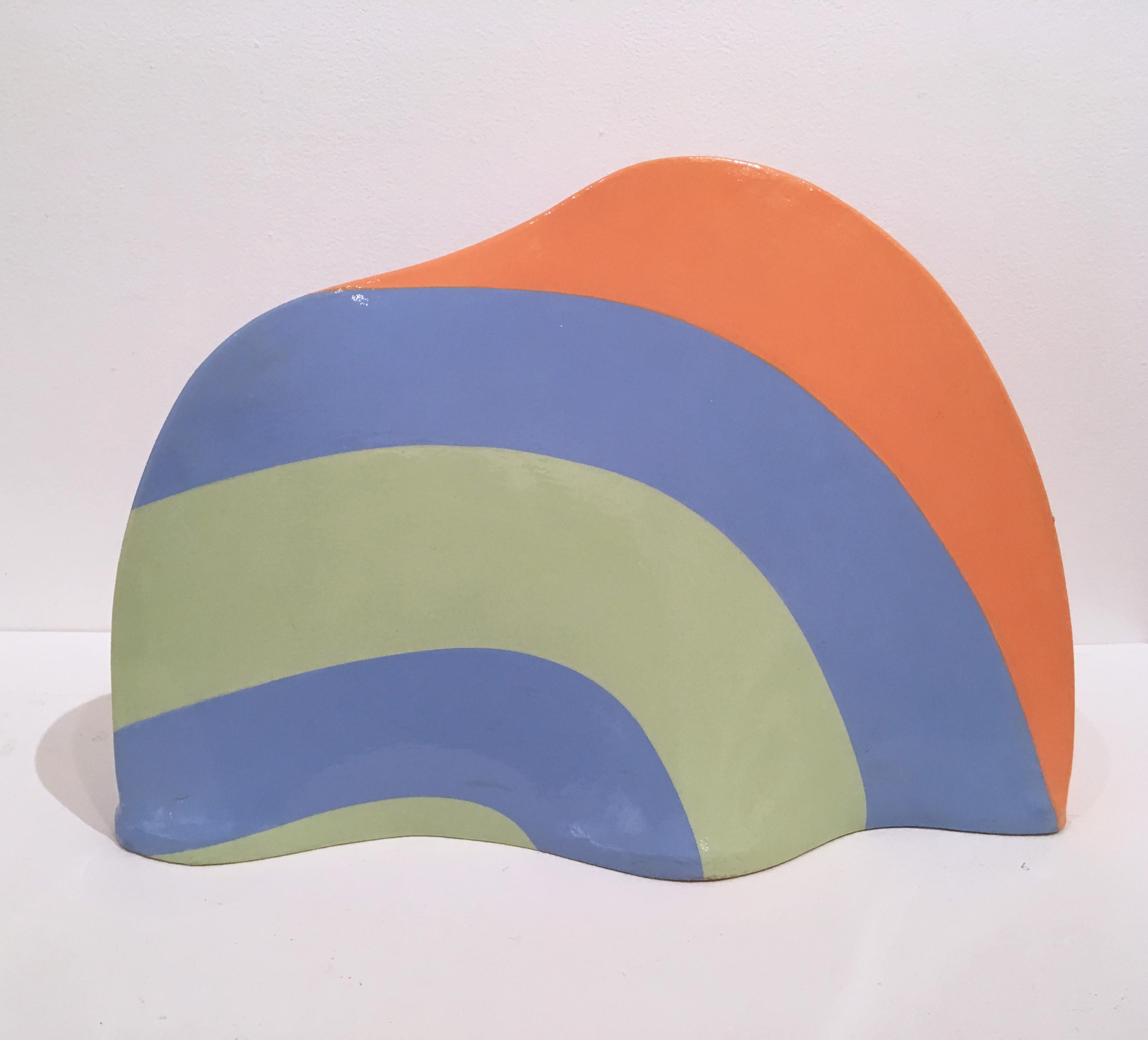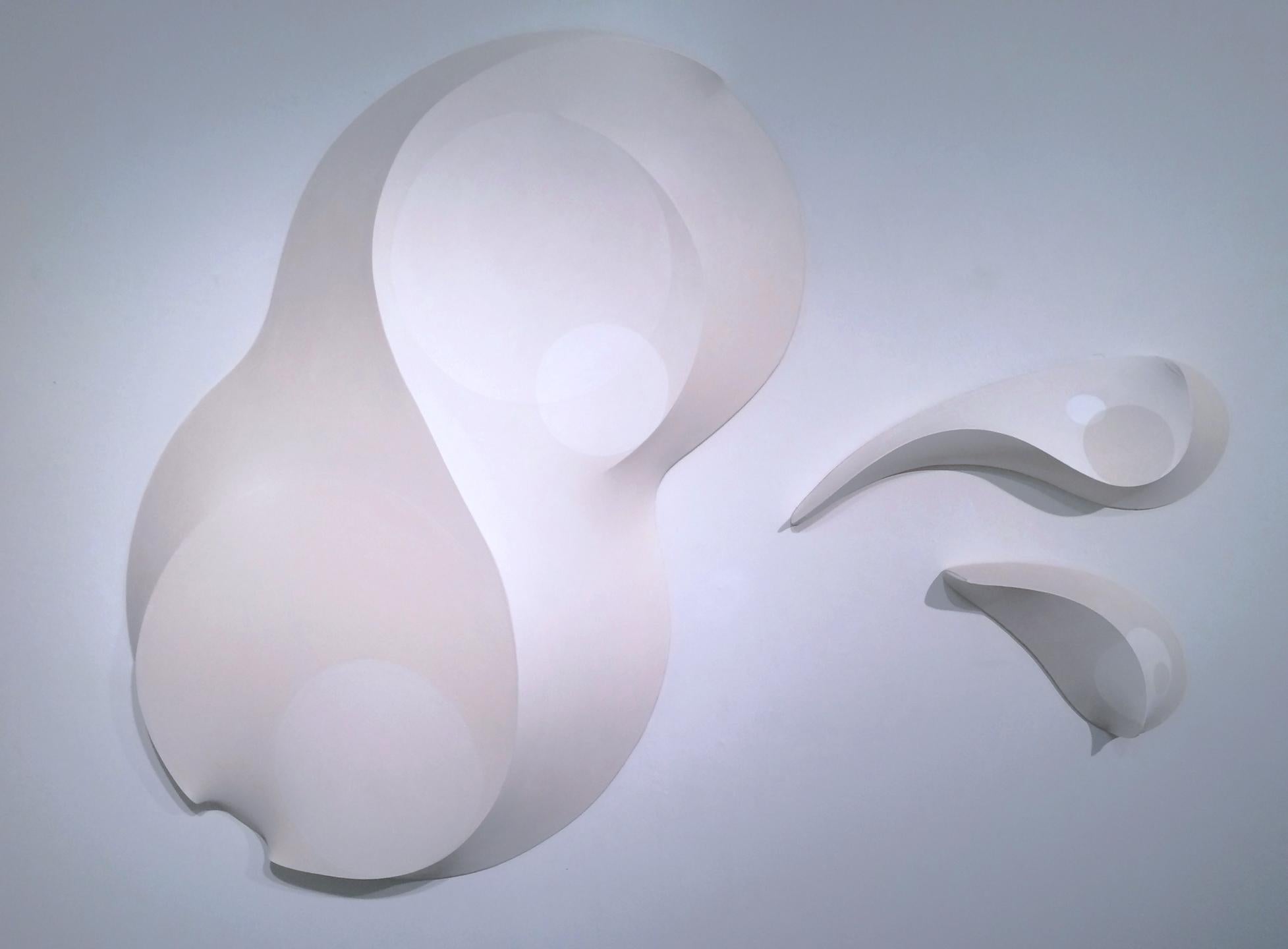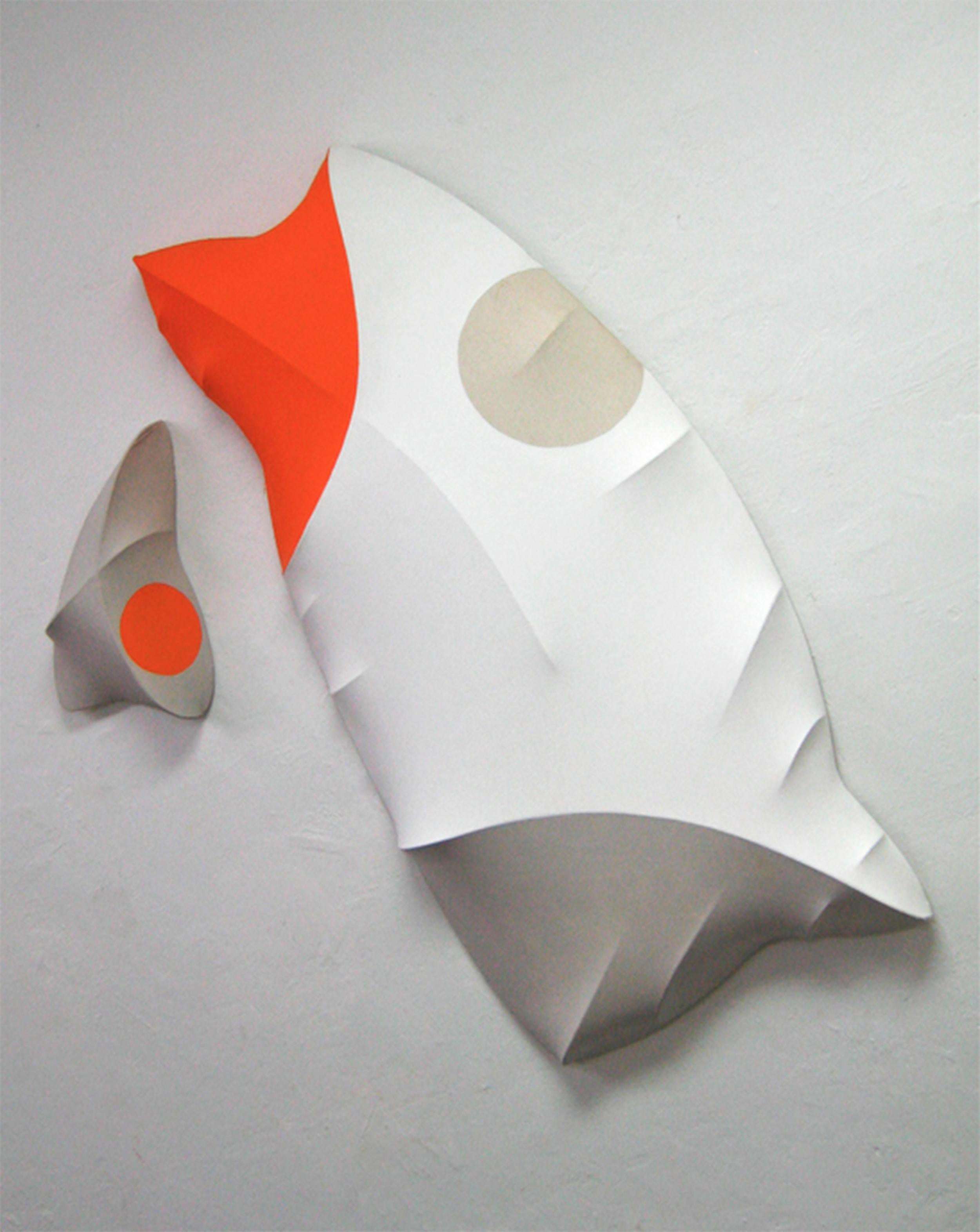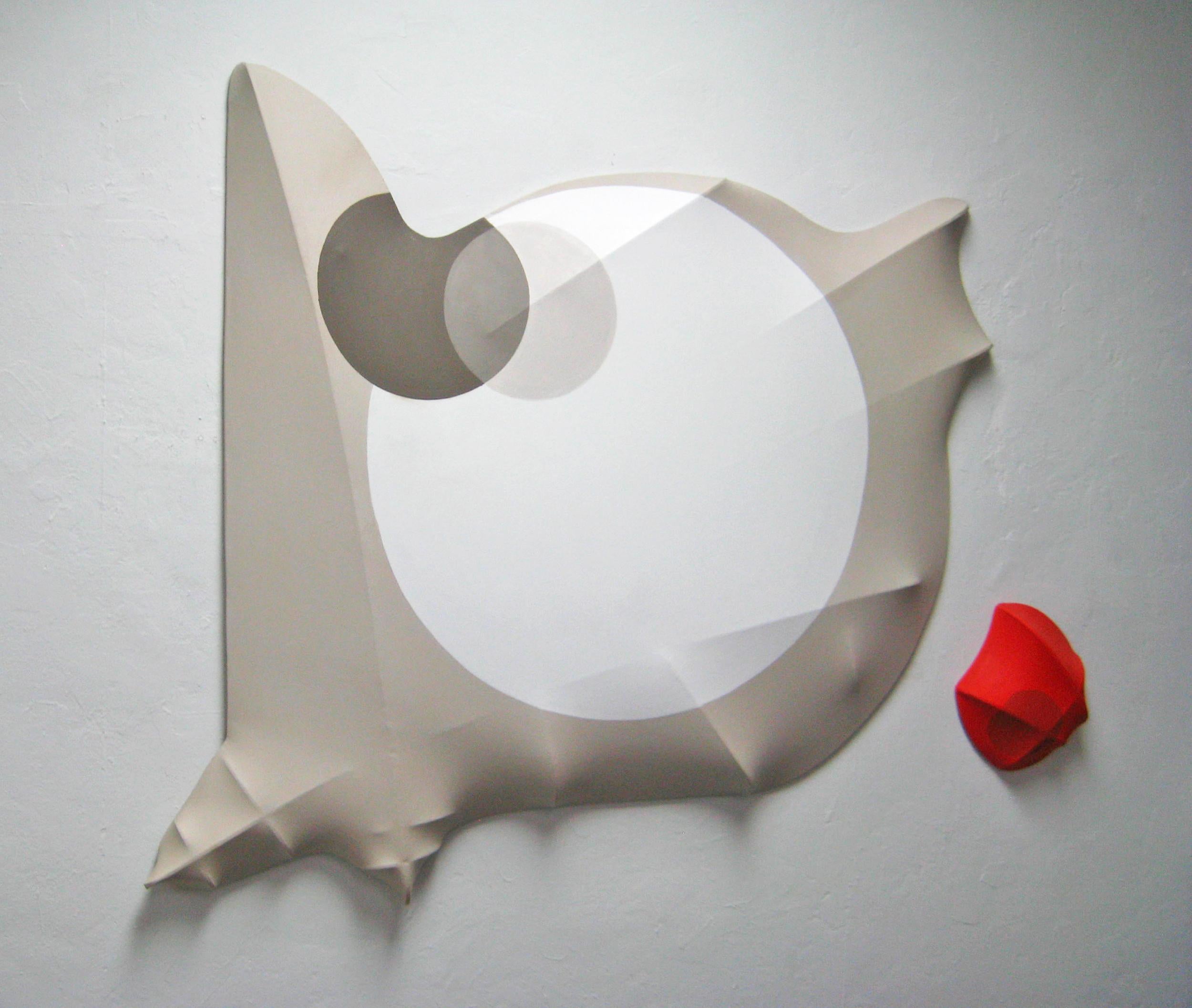Items Similar to "Message I, " Boris Margo, White Surrealist 3D Painting
Want more images or videos?
Request additional images or videos from the seller
1 of 5
Boris Margo"Message I, " Boris Margo, White Surrealist 3D Paintingcirca 1970
circa 1970
About the Item
Boris Margo (1920 -1995)
Message I, circa 1970
Stretched canvas over relief
22 x 27 x 1 1/2 inches
Best known as a painter of surrealist imagery, Boris Margo was born in Wolotschisk, Ukraine, in Russia. In 1919 he enrolled at the Polytechnik of Art at Odessa, and in 1924 received a grant to study at the Futemas (Workshop for the Art of the Future) in Moscow. A second grant enabled him to study the work of the Old Masters in the Hermitage Museum in Leningrad and to attend Pavel Filonov's Analytical School of Art in 1927.
In 1928 Margo received a certificate from the Polytechnik and immigrated to Montreal, where he worked as a muralist for a year. Moving to New York City in 1930, he studied at the Roerich Museum, and two years later began teaching there. He began experimenting with celluloid and acetone in his printmaking and was also an early user of the decalomania technique in oil painting.
In 1943 he became an American citizen. Five years later Margo founded a Creative Art Seminar (later called Artists Gallery) in Orlando, Florida, and a year later established a similar venture in Provincetown, Massachusetts.
Margo's first solo exhibition was at the Artists Gallery in New York City. Other important shows were held at the Brooklyn Museum, the Tweed Gallery at the University of Minnesota, Duluth, and the Michael Rosenfeld Gallery in New York in 1993.
- Creator:Boris Margo (1902, American)
- Creation Year:circa 1970
- Dimensions:Height: 22 in (55.88 cm)Width: 27 in (68.58 cm)Depth: 1.5 in (3.81 cm)
- Medium:
- Movement & Style:
- Period:
- Condition:
- Gallery Location:New York, NY
- Reference Number:1stDibs: LU184129924672
About the Seller
5.0
Platinum Seller
These expertly vetted sellers are 1stDibs' most experienced sellers and are rated highest by our customers.
Established in 2021
1stDibs seller since 2022
59 sales on 1stDibs
Typical response time: 1 hour
- ShippingRetrieving quote...Ships From: New York, NY
- Return PolicyA return for this item may be initiated within 3 days of delivery.
More From This SellerView All
- "Untitled, " Seymour Fogel, Geometric Abstraction, Texas Hard-EdgeBy Seymour FogelLocated in New York, NYSeymour Fogel Untitled Oil on illustration board construction 10 x 7 1/2 inches Provenance: Estate of the artist Charles and Faith McCracken Larry and Trish Heichel Private Collection Seymour Fogel was born in New York City on August 24, 1911. He studied at the Art Students League and at the National Academy of Design under George Bridgeman and Leon Kroll. When his formal studies were concluded in the early 1930s he served as an assistant to Diego Rivera who was then at work on his controversial Rockefeller Center mural. It was from Rivera that he learned the art of mural painting. Fogel was awarded several mural commissions during the 1930s by both the Works Progress Administration (WPA) and the Treasury Section of Fine Arts, among them his earliest murals at the Abraham Lincoln High School in Brooklyn, New York in 1936, a mural in the WPA Building at the 1939-1940 New York World's Fair, a highly controversial mural at the U.S. Post Office in Safford, Arizona (due to his focus on Apache culture) in 1941 and two murals in what was then the Social Security Building in Washington, D.C., also in 1941. Fogel's artistic circle at this time included Phillip Guston, Ben Shahn, Franz Kline, Rockwell Kent and Willem de Kooning. In 1946 Fogel accepted a teaching position at the University of Texas at Austin and became one of the founding artists of the Texas Modernist Movement. At this time he began to devote himself solely to abstract, non-representational art and executed what many consider to be the very first abstract mural in the State of Texas at the American National Bank in Austin in 1953. He pioneered the use of Ethyl Silicate as a mural medium. Other murals and public works of art done during this time (the late 1940s and 1950s) include the Baptist Student Center at the University of Texas (1949), the Petroleum Club in Houston (1951) and the First Christian Church, also in Houston (1956), whose innovative use of stained glass panels incorporated into the mural won Fogel a Silver Medal from the Architectural League of New York in 1958. Fogel relocated to the Connecticut-New York area in 1959. He continued the Abstract Expressionism he had begun exploring in Texas, and began experimenting with various texturing media for his paintings, the most enduring of which was sand. In 1966 he was awarded a mural at the U.S. Federal Building in Fort Worth, Texas. The work, entitled "The Challenge of Space", was a milestone in his artistic career and ushered in what has been termed the Transcendental/Atavistic period of his art, a style he pursued up to his death in 1984. Painted and raw wood sculpture...Category
Mid-20th Century Abstract Geometric Abstract Paintings
MaterialsOil, Board
- "Voyage I, " Rosamond Berg, Female Contemporary Minimalist Sculpture ArtistLocated in New York, NYRosamond Berg (American, 1931 - 2018) Voyage I, 1982 Mixed media construction including hand-dyed cotton cloth pouches 24 x 24 inches Signed, titled an...Category
1980s Contemporary Abstract Sculptures
MaterialsCotton, Thread, Glass, Wood
- "Untitled" Mario Yrisarry, Geometric Abstraction, Color Field, Rainbow SquaresBy Mario YrisarryLocated in New York, NYMario Yrisarry Untitled, 1973 Signed and dated on the overlap Acrylic on canvas 48 x 48 inches Provenance: Private Collection, Ellicott City, Maryland ...Category
1970s Abstract Geometric Abstract Paintings
MaterialsCanvas, Acrylic
- "Jean Jean" Larry Zox, Color Field, Geometric Abstraction, Hard-Edge, YellowBy Larry ZoxLocated in New York, NYLarry Zox Jean Jean, 1964 Signed, dated, and titled on the stretcher Liquitex on canvas 58 x 62 inches Provenance: Solomon & Co., New York Private Collection, NJ Estate of the above, 2023 Committed to abstraction throughout his career, Larry Zox played a central role in the Color Field discourse of the 1960s and 1970s. His work of the time, consisting of brilliantly colored geometric shapes in dynamic juxtapositions, demonstrated that hard-edge painting was neither cold nor formalistic. He reused certain motifs, but he did so less to explore their aspects than to “get at the specific character and quality of each painting in and for itself,” as James Monte stated in his essay for Zox’s solo exhibition at the Whitney Museum of American Art in 1973. By the 1970s, Zox was using a freer, more emotive method, while maintaining the autonomy of color, which increasingly became more important to him than structure in his late years. Zox began to receive attention in the 1960s, when he was included in several groundbreaking exhibitions of Color Field and Minimalist art, including Shape and Structure (1965), organized by Henry Geldzahler for the Gallery of Modern Art, New York, and Systemic Painting (1966), organized by Lawrence Alloway for the Guggenheim Museum. In 1973, the Whitney’s solo exhibition of Zox’s work gave recognition to his significance in the art scene of the preceding decade. In the following year, Zox was represented in the inaugural exhibition of the Hirshhorn Museum, which owns fourteen of his works. Zox was born in Des Moines, Iowa. He attended the University of Oklahoma and Drake University. While studying at the Des Moines Art Center, he was mentored by George Grosz, who despite his own figurative approach encouraged Zox’s forays into abstraction. In 1958, Zox moved to New York, joining the downtown art scene. His studio on 20th Street became a gathering place for artists, jazz musicians, bikers, and boxers. He occasionally sparred with the visiting fighters. He later established a studio in East Hampton, where he painted and fished including using a helicopter to spot fish. In the 1950s and early 1960s, Zox’s works were collages consisting of painted pieces of paper stapled onto sheets of plywood. He then produced paintings that were illusions of collages, including both torn- and trued-edged forms, to which he added a wide range of intense hues that created ambiguous surfaces. Next, he omitted the collage aspect of his work and applied flat color areas to create more complete statements of pure color and shape. From 1962 to 1965, he produced his Rotation Series, at first creating plywood and Plexiglas reliefs, which turned squares into dynamic polygons. He used these shapes in his paintings as well, employing white as a foil between colors to produce negative spaces that suggest that the colored shapes had only been cut out and laid down instead of painted. The New York Times noted in 1964: “The artist is hip, cool, adventurous, not content to stay with the mere exercise of sensibility that one sees in smaller works.” In 1965, he began the Scissors Jack...Category
1960s Abstract Geometric Abstract Paintings
MaterialsCanvas, Acrylic
- "Ouverture, with Cypress Forms" Stephen Edlich, Abstract Geometric PaintingBy Stephen EdlichLocated in New York, NYStephen Edlich Ouverture, with Cypress Forms, 1982 Signed, dated and titled on the stretcher Acrylic paint, mixed media, and burlap on canvas 60 x 40 inches An artist who worked in the post-cubist and constructivist traditions, Stephen P. Edlich gained a considerable amount of acclaim in the 1970s and 1980s for his collages, sculpture, and paintings. His promising career was cut short due to his untimely death at age 45 in 1989. Edlich was born in New York City. He received his undergraduate degree with a major in fine arts studies from New York University in 1967. During his college years, he traveled to London, where he met the art dealer Victor Waddington and created his first white on white collage. In that same year, he attended a major exhibition of the work of Ben Nicholson, which would be influential source in his art. Edlich returned to England in 1967, where he met Barbara Hepworth and Patrick Heron in London and traveled to St. Ives, Cornwall, long a favorite artists' haunt. Edlich began creating acrylic reliefs...Category
1980s Abstract Geometric Abstract Paintings
MaterialsCanvas, Burlap, Mixed Media, Acrylic
- "Untitled" Dan Christensen, Geometric Plaid Series, Orange and Blue AbstractBy Dan ChristensenLocated in New York, NYDan Christensen Untitled, circa 1970-71 Acrylic and enamel on canvas 44 x 20 inches Provenance: The artist Sherron Francis (gift from the above) Dan Christensen was an American abs...Category
1970s Abstract Geometric Abstract Paintings
MaterialsEnamel
You May Also Like
- Number 29, Vertebrate Companion Series, 2012, oil on canvas, wall sculptureBy George GoodridgeLocated in Jersey City, NJOil on 3-D stretched canvas, dimensions listed for piece as shown. Dimensions are variable depending on hanging formation. Wall sculpture, orange, green, and purple.Category
2010s Abstract Geometric Abstract Paintings
MaterialsOil, Canvas, Wood
- Hope, 2020, Acrylic on stretched canvas, wood armature, black, wall sculptureBy George GoodridgeLocated in Jersey City, NJAcrylic on 3-D stretched canvas with wood armature. Dimensions listed for piece as shown. Dimensions are variable depending on hanging formation. Wall sculpture, black, orange, red a...Category
2010s Abstract Geometric Abstract Paintings
MaterialsWood, Acrylic, Canvas
- Number 26, Vertebrate Companion Series, 2012, acrylic on canvas, wall sculptureBy George GoodridgeLocated in Jersey City, NJAcrylic on 3-D stretched canvas, dimensions listed for piece as shown. Dimensions are variable depending on hanging formation. Wall sculpture, white, red, and gray.Category
2010s Abstract Geometric Abstract Paintings
MaterialsCanvas, Wood, Acrylic
- Waves of Contentment 2, 2019, acrylic, resin on 3-D stretched canvas, sculptureBy George GoodridgeLocated in Jersey City, NJAcrylic and resin on 3-D stretched canvas. Sculpture, blue, green, orange. Abstract, biomorphic.Category
2010s Abstract Geometric Abstract Paintings
MaterialsCanvas, Resin, Wood, Acrylic
- Waves of Contentment 1, 2019, acrylic, resin on 3-D stretched canvas, sculptureBy George GoodridgeLocated in Jersey City, NJAcrylic and resin on 3-D stretched canvas. Sculpture, blue, green, orange. Abstract, biomorphic.Category
2010s Abstract Geometric Abstract Paintings
MaterialsCanvas, Wood, Acrylic, Resin
- Beauty is Eternity Gazing at Itself In the Mirror, 2013, Acrylic wall sculptureBy George GoodridgeLocated in Jersey City, NJAcrylic on 3-D stretched canvas with wood armature. Dimensions listed for piece as shown. Dimensions are variable depending on hanging formation. Wall sculpture, white, tan, and gray.Category
2010s Abstract Geometric Abstract Paintings
MaterialsCanvas, Wood, Acrylic





